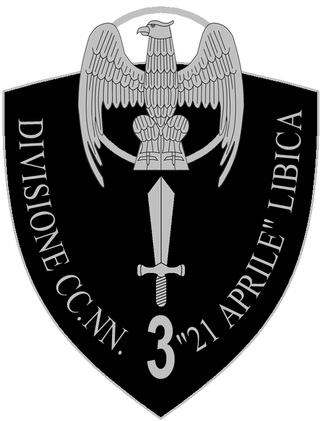
Operation Compass was the first large British military operation of the Western Desert Campaign (1940–1943) during the Second World War. British, Empire and Commonwealth forces attacked Italian forces of the 10th Army in western Egypt and Cyrenaica, the eastern province of Libya, from December 1940 to February 1941.

The Corps of Volunteer Troops was a Fascist Italian expeditionary force of military volunteers, which was sent to Spain to support the Nationalist forces under General Francisco Franco against the Spanish Republic during the Spanish Civil War, 1936–39.

The 1st CC.NN. Division "23 Marzo" was an Italian CC.NN. division raised on 23 April 1935 for the Second Italo-Ethiopian War against Ethiopia. The name "23 Marzo" was chosen to commemorate the founding date of the Fasci Italiani di Combattimento on 23 March 1919. The division took part in the Italian invasion of Egypt and was destroyed during the Battle of Bardia in January 1941.
The Order of battle of the East African campaign shows the ground forces of both sides in East Africa on the date that the Italians declared war on Britain and France, 10 June 1940 and for the British and Commonwealth forces involved in the 1941 offensive.

The 2nd CC.NN. Division "28 Ottobre" was an Italian CC.NN. division raised on 10 May 1935 for the Second Italo-Ethiopian War against Ethiopia. The name "28 Ottobre" was chosen to commemorate the Fascist March on Rome on 28 October 1922. The division took part in the Italian invasion of Egypt and was destroyed during the Battle of Bardia in January 1941.

The 3rd CC.NN. Division "21 Aprile" was an Italian CC.NN. division raised on 10 June 1935 for the Second Italo-Ethiopian War against Ethiopia and disbanded shortly before Italy's entry into World War II. The name "21 Aprile" was chosen to commemorate the legendary date of the founding of Rome.

The 4th CC.NN. Division "3 Gennaio" was an Italian CC.NN. division raised on 25 June 1935 for the Second Italo-Ethiopian War against Ethiopia. The name "3 Gennaio" was chosen to commemorate the date of assumption of dictatorial powers by Benito Mussolini on 3 January 1925. The division took part in the Italian invasion of Egypt and was destroyed during the Battle of Sidi Barrani in December 1940.
The 5th CC.NN. Division "1 Febbraio" was an Italian CC.NN. division raised on 15 July 1935 for the Second Italo-Ethiopian War against Ethiopia and disbanded shortly after the war. The name "1 Febbraio" was chosen to commemorate the founding of the Milizia Volontaria per la Sicurezza Nazionale on 1 February 1923.
The 7th CC.NN. Division "Cirene" was an Italian CC.NN. division raised on 27 April 1936 for the Second Italo-Ethiopian War against Ethiopia and disbanded on 15 September 1936 after the war's end. The name "Cirene" was chosen to commemorate the Roman city of Cyrene located in the Cyrenaica, where the division was deployed. The division's commander was Lieutenant General Guido Scandolara. The division was deployed in Libya during the war against Abyssinia to threaten the Suez Canal should the British close it to Italian traffic. It was never deployed to Abyssinia, but was considered to take part in the campaign. It actually acted as a local garrison and engaged in various construction projects.
The 1st CC.NN. Division "Dio lo Vuole", was one of the three Italian Blackshirts Divisions sent to Spain during the Spanish Civil War to make up the "Corpo Truppe Volontarie", or CTV.
3rd CC.NN. Division "Penne Nere",, was one of the three Blackshirt divisions sent to Spain during the Spanish Civil War to make up the "Corpo Truppe Volontarie", or CTV.
The XXIII de Marzo Group was one of the Blackshirt units sent to Spain during the Spanish Civil War to make up the "Corpo Truppe Volontarie", or CTV. This unit was attached to the 2nd CCNN Division "Fiamme Nere" during the Battle of Guadalajara in March 1937. Following defeat there, it was sent to Vizcaya in April 1937 with the Flechas Negras Mixed Brigade and 11 Groups of CTV Corps Artillery.
This is the order of battle for the Battle of Guadalajara during the Spanish Civil War.
The Agrupación XXIII de Marzo was upgraded to Division status as the Division XXIII Marzo prior to the Battle of Santander. It was one of the Italian Blackshirts units sent to Spain during the Spanish Civil War to make up the "Corpo Truppe Volontarie", or CTV. Was strengthened after the end of the War in the North for the Aragon Offensive in 1938 with 2nd CCNN Division "Fiamme Nere" and renamed XXIII Marzo Division "Fiamme Nere".

The 1st Infantry Division "Superga" was an infantry division of the Royal Italian Army during World War II. The Superga was classified as a mountain infantry division, which meant that the division's artillery was moved by pack mules instead of the horse-drawn carriages of line infantry divisions. Italy's real mountain warfare divisions were the six alpine divisions manned by Alpini mountain troops. The Superga recruited primarily from central Piedmont and was based, together with its two infantry regiments, in Turin, while the 5th Artillery Regiment was based in Venaria Reale. The division was and named for the Superga hill near Turin, where members of Italy's Royal House of Savoy were buried in the Basilica of Superga.
The 2nd Libyan Division was an infantry division of the Royal Italian Army during World War II. In December 1940 the division formed, together with the 1st CC.NN. Division "23 Marzo" and 2nd CC.NN. Division "28 Ottobre", the XXIII Army Corps. The corps participated in the Italian invasion of Egypt and was destroyed during the Battle of Sidi Barrani.

The 136th Armored Legionary Division "Centauro" was an armored division of the Royal Italian Army during World War II. The division had been formed in June 1942 as 1st CC.NN. Armored Division "M", but was renamed after the fall of the fascist regime in July 1943. In September 1943 it was in training near Rome and was disbanded by the Germans after the announcement of the Armistice of Cassibile.

The 40th Infantry Division "Cacciatori d’Africa" was an infantry division of the Royal Italian Army during World War II. The Cacciatori d’Africa was formed on 27 July 1940 from troops and reservists stationed in Italian East Africa. The Cacciatori d’Africa, together with the 65th Infantry Division "Granatieri di Savoia" were outside the regular Royal Italian Army chain of command, and subordinated directly to Prince Amedeo, Duke of Aosta, the Viceroy of Italian East Africa. The division dissolved on 15 May 1941 after being decimated during the East African campaign.

The 50th Infantry Division "Regina" was an infantry division of the Royal Italian Army during World War II. The Regina was formed on 1 March 1939 in the Italian Islands of the Aegean and entitled to the Queen. After the announcement of the Armistice of Cassibile between Italy and the Allies on 8 September 1943 the division fought Wehrmacht forces in the Battle of Rhodes. The majority of the division surrendered on 11 September 1943, while the III Battalion, 10th Infantry Regiment "Regina" resisted the Germans on Leros until 16 November 1943.

The Voluntary Militia for National Security, commonly called the Blackshirts or squadristi, was originally the paramilitary wing of the National Fascist Party, known as the Squadrismo, and after 1923 an all-volunteer militia of the Kingdom of Italy under Fascist rule, similar to the SA. Its members were distinguished by their black uniforms and their loyalty to Benito Mussolini, the Duce (leader) of Fascism, to whom they swore an oath. The founders of the paramilitary groups were nationalist intellectuals, former army officers and young landowners opposing peasants' and country labourers' unions. Their methods became harsher as Mussolini's power grew, and they used violence and intimidation against Mussolini's opponents. In 1943, following the fall of the Fascist regime, the MVSN was integrated into the Royal Italian Army and disbanded.










